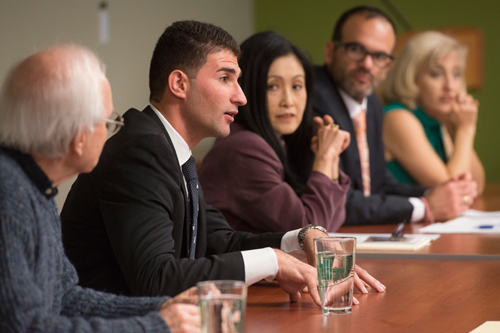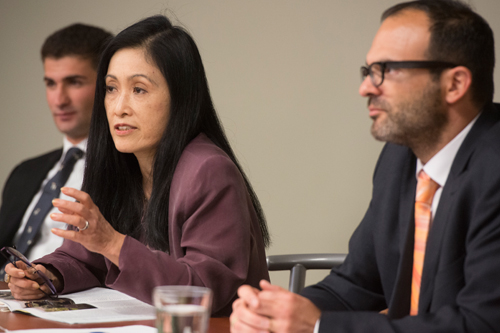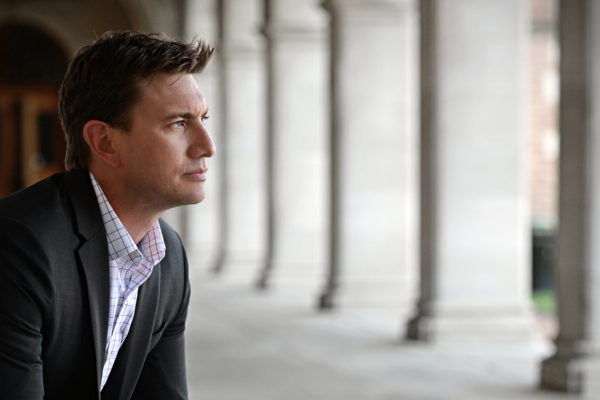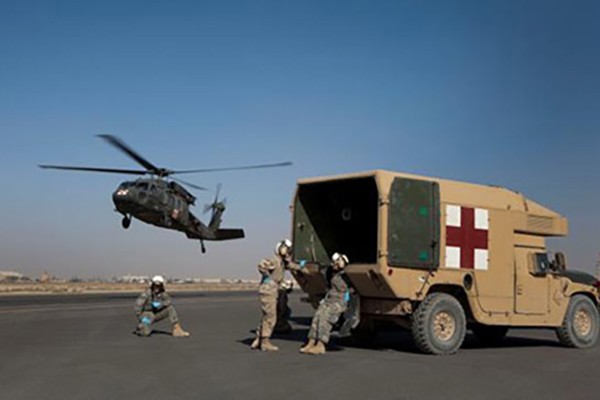While recent surveys (including the Pew Research Center, The New York Times and the Associated Press) suggest the American public is ready to bring its soldiers home, the Afghan people seem to view the withdrawal with much trepidation.
Some reports estimate that more than 36,000 Afghans have already left the country. STATT, a nongovernmental organization that conducts migration research and polling, reported in January 2013 that the “fear of instability in 2014 is driving emigration of the very people and money that could prevent instability.”Against this backdrop, Washington Magazine asked journalist Fariba Nawa, author of Opium Nation: Child Brides, Drug Lords, and One Woman’s Journey Through Afghanistan, to interview our faculty and alumni with special expertise on the region. Topics discussed include the country’s future with regard to security, human rights, the fragile economy and the status of U.S. involvement.
Topic: stability & security
Jean-Francois Trani, PhD, Assistant Professor, Brown School
AREAS OF EXPERTISE: Poverty, gender and disability issues in Afghanistan
The billion-dollar question is what will happen to Afghanistan after the troop withdrawal, but there isn’t one answer, says Jean-Francois Trani, PhD, assistant professor at the Brown School, who has done extensive research in Afghanistan.
Trani’s work on the country’s current conditions is diverse, including research on poverty, gender issues and, most recently, disability issues.
Having just spent June 2013 in Afghanistan (Kabul, Mazar, Kunduz, Taloqan, Jalalabad), Trani believes the most optimistic scenario is that Afghanistan will be a peaceful country without conflict once the troops withdraw. Yet the most likely scenario is a relatively low-intensity conflict, with the main cities and roads continuing under the control of the central government and President Karzai’s allies (the former mujahideen), and the large rural areas under the control of insurgents against the central government, particularly various Taliban groups.
“Relative stability will depend upon the results of the 2014 Afghan presidential elections. A fairly elected government would do a lot to improve the trust of the population.”
Jean-Francois Trani, PhD
“Relative stability will depend upon the results of the 2014 Afghan presidential elections,” Trani says. “A fairly elected government would do a lot to improve the trust of the population.” The popular perception is that the Karzai government and its allies have worked harder to fight the Taliban than to fight internal corruption.
Trani says external support for special interests is another wild card. The countries of Pakistan, India, Iran and China all have their own agendas in the country, he says, and Afghan forces do not have the capacity to maintain law and order.
According to his research, the limited progress that has been made over the last 12 years — in areas such as education, health care, infrastructure and livelihoods — could be in jeopardy.
At this point, Trani concludes that concerns beyond surviving are not at the forefront for most Afghans.
“Afghans are thinking of basic survival,” he says. “More than anything, the common man is concerned about his capacity to generate enough resources to feed his family.

Topic: human rights
Leila Nadya Sadat, JD, LLM, DEA, the Henry H. Oberschelp Professor of Law
Director, The Whitney R. Harris World Law Institute
AREAS OF EXPERTISE: War crimes and crimes against humanity
Leila Nadya Sadat, JD, LLM, DEA, the Henry H. Oberschelp Professor of Law and director of the Whitney R. Harris World Law Institute, says the United States has a responsibility to assist in bringing human rights to Afghanistan after 12 years of occupation.
As a special adviser on crimes against humanity to the International Criminal Court (ICC), Sadat says the ICC has received nearly 100 allegations of crimes against humanity (systematic beatings, torture and killings) and war crimes since 2006 from Afghanistan, and the court is currently examining these cases.
On May 1, 2003, Afghanistan ratified the Rome Statute of the ICC, which gives the court the right to investigate these reports and prosecute the criminals. Sadat says Afghanistan’s acceptance of the court’s jurisdiction is a big step forward for accountability and justice. If the ICC issues arrest warrants against Afghan nationals, the Afghan government must help arrest the perpetrators so that the ICC can try them in The Hague.
The best approach to progress post-2014, according to Sadat, may be a truth and reconciliation commission.
“The worst perpetrators should be tried.”
Leila Nadya Sadat, JD, LLM, DEA
Sadat says Afghans must form a grassroots movement from the bottom up to be effective in the long term. She sees many Afghans working hard to regain what they lost after the Soviet invasion: a fairly stable, safe and tolerant country. The challenges are immense, yet Sadat believes “in the tremendous courage of Afghan men and women” to advance.
With regard to the advancement of women’s rights, in particular, Assistant Professor Trani says political factors will play a deciding role. If, for example, members of the Taliban rule a large part of the country, they would again impose their strict interpretation of tribal ethics.
Economic factors also will impact women’s rights. Trani’s research shows that men with more economic opportunities have more self-esteem, less anxiety and, ultimately, a more balanced relationship with women in their household. “This will allow women to negotiate for their rights,” Trani says. “But, I believe, mentalities will take another generation to start changing.”
Topic: social affairs
Robert Canfield, PhD, Professor Emeritus of Sociocultural Anthropology
AREAS OF EXPERTISE: Islamic movements in Afghanistan, Pakistan and other Central Asian countries
The technological changes in the last 12 years in Afghanistan can lead to greater social change in the future, says Robert Canfield, PhD, professor emeritus of sociocultural anthropology in Arts & Sciences and an expert on the war-torn country.
Canfield, who lived in Afghanistan for nine years, has done extensive research on social affairs in the country since the 1960s.
“Technological changes have already been huge,” Canfield says. “I have been told that in a country of 30 million, 22 million have cell phones. Those phones will change, have changed, the means of social interaction and economic activity.”
Yet social mores will take longer to change, he says. For example, women’s rights and education are less likely to advance. Recent media coverage shows that many young Afghan men do not believe that women deserve the same rights as them.
According to Canfield, whether or not those areas will change depends on who is in control. Depending on the region, Afghanistan is controlled by different groups: the Karzai government, warlords, the Taliban.
The relationship between the Taliban and Pakistan has been the most problematic, he says. “They [Pakistanis] have been nourishing the Taliban all along,” Canfield says. For the last 24 years, Schramm has worked in the international development field in 26 countries, including Iraq and Afghanistan. As senior trans-boundary water rights adviser in Afghanistan, he developed recommendations on water usage between the country and its neighbors. Four of Afghanistan’s five water basins touch other countries, but international rules must be applied for equitable use of the water. Negotiations, especially with Pakistan, hold some promise.
The relationship between the Taliban and Pakistan has been the most problematic, he says. “They [Pakistanis] have been nourishing the Taliban all along.”
Robert Canfield, PhD
Secretary of State John Kerry visited Pakistan in summer 2013 in hopes of finding a solution to the cross-border conflict. According to Canfield, Pakistan has its own divisions, and its current leaders are concerned with sustaining their own power and interests, not necessarily with Afghanistan’s future.
As for Iran, another neighbor and strategic player in Afghanistan’s future, Canfield says its new president may sustain the same policy toward Afghanistan post-2014. However, Iran’s pro-Islamic Revolutionary Guard may have other plans.
“The Revolutionary Guard has historically supported Shiites and Farsi/Persian speakers in Afghanistan, but since the U.S. ousted the Taliban, reports point to covert Iranian support for the Taliban,” Canfield says. “Iran is uncomfortable with Afghanistan’s closeness to the United States and has tried to convince Karzai to distance himself from Americans.”
Topic: economic development
Jack Schramm, JD ’59
AREA OF EXPERTISE: International development
If managed well, the vast mineral deposits in Afghanistan could be used to advance the country’s economy, says Jack Schramm, JD ’59, an international development expert.Afghanistan’s economy could flourish with international support, he believes. He also believes the United States should remain in the country with enough troops to continue training Afghan forces and to quell Taliban uprisings.
For the last 24 years, Schramm has worked in the international development field in 26 countries, including Iraq and Afghanistan. As senior trans-boundary water rights adviser in Afghanistan, he developed recommendations on water usage between the country and its neighbors. Four of Afghanistan’s five water basins touch other countries, but international rules must be applied for equitable use of the water. Negotiations, especially with Pakistan, hold some promise.
Afghanistan’s economy could flourish with international support, he believes. He also believes the United States should remain in the country with enough troops to continue training Afghan forces and to quell Taliban uprisings.
According to Schramm, the pullout in Iraq provides a cautionary tale about the potential for instability. Whereas in Iraq, the government has overcentralized its power, in decentralized Afghanistan, the government suffers from a lack of control over its people. But both nation-states deserve the United States’ help, he says.
“If we don’t want to revisit an instability that is likely to get out of hand even more quickly than we have witnessed in Iraq, then we need to remain in Afghanistan for some time.”
Jack Scharm, JD ’59
Topic: U.S. military involvement
Raymond Gobberg, AB ’08 (political science)
William Hartel, DDM ’85
AREA OF EXPERTISE: Firsthand military experience
Rumi Kato Price, PhD, MPE ’90, Professor of Psychiatry
AREAS OF EXPERTISE: Trauma, post-traumatic stress disorder, substance abuse and suicide in U.S. military
For reserve soldier Raymond Gobberg, AB ’08, one of the most important lessons he learned on active duty in Afghanistan was to build trust among the local Afghan population.Even so, three years after his tour of duty, Gobberg feels strongly that the U.S. should stay engaged, whether through military installations, diplomatic missions, aid or development.
“People we interacted with ran the risk of being intimidated or killed because they associated with us.”
Raymond Gobberg, AB ’08
Working in the region was difficult, he says, because the military’s rotation of personnel did not allow for the time needed to build long-term relationships. Gobberg also faced security obstacles — insurgents tried to attack his unit on a few occasions.
“People we interacted with ran the risk of being intimidated or killed because they associated with us,” Gobberg says. “Because their safety was also at risk, I struggled with how much we were assisting the people we were supposed to be assisting.”
Even so, three years after his tour of duty, Gobberg feels strongly that the U.S. should stay engaged, whether through military installations, diplomatic missions, aid or development.
“Afghanistan is a strategic country in that region, especially given its neighbors,” Gobberg says. “It’s important that we maintain a respectful relationship with whoever’s governing.”
Gobberg returned to St. Louis with a Bronze Star for his work in Afghanistan, and, since coming home, co-founded Bonfyre, a social networking app. He’s also pursuing a master’s in political management. Gobberg says he’s simply lucky that he never had to fire his gun in active combat and that he returned without PTSD or other war-related trauma.
According to Rumi Kato Price, PhD, MPE ’90, professor of psychiatry, Gobberg’s experience is not uncommon. And her research shows reason for optimism about the future of returning soldiers.
Price, who has studied trauma, post-traumatic stress disorder, substance abuse and suicide among the new generation of American military service members and their families, as well as older Vietnam veterans, says “the notion that our soldiers deployed to conflict regions come back ‘broken’ is a one-sided story in the media. There are both potential positive and negative effects of war experiences.”

Price’s current research on National Guard members indicates a positive experience of deployment. Further, stories of veterans and service members include an element of “post-traumatic growth,” an idea that people can grow in positive ways from traumatic experiences. Those who do suffer from war trauma and health issues are less likely to be stigmatized since the military’s recognition of PTSD as a medical problem.
Yet only 40 percent of service members and veterans who present mental-health problems seek treatment. And some of those who do seek treatment may have a long wait for their claims to be processed, making it difficult to receive timely assistance.
These delays could contribute to rising suicide rates among military service members (now at 23 per 100,000 in the Army), which have steadily increased since 2002. War combat also may be a contributor to this rise, but experts disagree about its impact. A report recently published in The Journal of the American Medical Association and other studies point to mental illness, substance abuse, and relationship and financial problems as possible causative factors for military service members, as in the civilian population.
One way to prevent suicide among service members, Price advocates, is to implement “means restriction.” At least for those who communicate their suicidal thoughts after deployment, some measures to restrict their access to firearms could be developed.
With regard to substance abuse, U.S. troops inside Afghanistan and other conflict regions show little evidence of increased illicit drug use, unlike during the Vietnam War, when soldiers returned home with opiate-addiction problems. Prescription-drug abuse, though, has tripled to 11 percent among service members, according to one recent military survey. And according to Price, other substance abuse — especially excessive alcohol use — often begins when service members get home and find it difficult to reintegrate into civilian life.
To assist soldiers in the reintegration process, Price suggests that universities and corporations could further expand their veteran employment and education outreach programs to help returning service members transition to civilian life. (Of note, Washington University participates in programs such as The Mission Continues for disabled veterans and the Yellow Ribbon Reintegration Program for the National Guard.)
Remarkably, the transition from civilian to military life can often be just as jarring.
Alumnus William Hartel, DDM ’85, for example, sold his dental practice in Brentwood, Mo., in 2011 and accepted a commission in the Army Reserves the following year.
“The Army has only half the dentists it needs,” Hartel says, “and I was told that if I joined, I would have a good chance of being deployed.” He completed Basic Training in 2013 and was immediately slated for a tour in Afghanistan.
From April through August of this year, Hartel provided emergency care to coalition forces seven days a week, dividing his time between the operating room, trauma bay and dental clinic.
The daily pressures of life on the front line required resilience, as well as an ability to withstand extreme weather and to deal with the military’s bureaucracy, he says. But despite these challenges, Hartel says, he and the other U.S. soldiers wanted to work in Afghanistan.
“People have their own reasons for joining the military,” Hartel says. “Some folks joined before 9/11, when the outlook for armed conflict was low, hoping to get college tuition benefits. Some joined after the attack out of urgent national pride, and still others more recently to take advantage of bonus payments. But, as a rule, everyone I met wanted to serve.”
“As a rule, everyone I met wanted to serve.”
William Hartel, DDM ’85
According to Hartel, the air base in Kandahar was attacked regularly, particularly during Ramadan. At one time, Afghans were permitted to seek care in the NATO facility. But just two months before Hartel’s arrival, a local entered the trauma bay wearing a suicide vest. Although her bomb failed to detonate, the woman’s actions effectively canceled local access to treatment there.
Similarly, the 2014 withdrawal of U.S. and NATO forces will reduce access to the additional resources Afghanistan has had for the past 12 years. And in that vacuum? History tells a story of a struggle for self-determination.
Since its founding in 1747, Afghanistan has been a place for rivaling empires to fight proxy wars. With successive occupations by the British, the Soviets and now the Americans, Afghanistan and its people have experienced ongoing conflict. Will neighboring China, with its interests in mining, become the next major player in Afghanistan? And what are Pakistan’s plans?
Compounding the country’s problems are a number of internal divisions — ethnic and religious — that have led to fractionalization.
And then there’s the matter of development. “There are resources, to be sure,” Hartel says, “but the average guy by himself can’t dig an oil well or a copper mine.”
Fariba Nawa is the author of Opium Nation: Child Brides, Drug Lords, and One Woman’s Journey Through Afghanistan (HarperCollins, 2011). Photographer Benjamin Lowy, BFA ’01, is a specialist in conflict and feature photography


